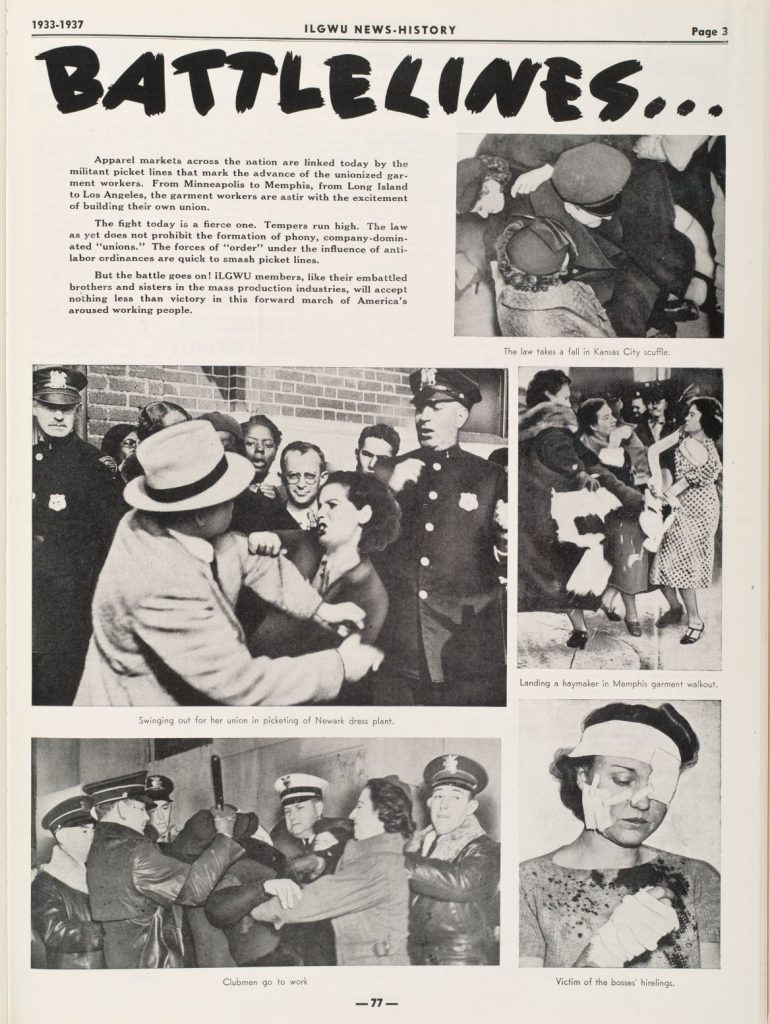Background
Labor unions were a critical part of the New Deal. Both the National Industrial Recovery Act of 1933 and the Fair Labor Standards Act of 1938 included protections for unions and required companies to negotiate with unions. Many unions shrunk during the 1920s, but new government involvement encouraged workers to join unions in large numbers. Membership in the International Ladies’ Garment Workers Union (ILGWU) quadrupled in one year (1934). Unions felt empowered to fight for better wages and hours with the government in their corner. When negotiations with companies did not work, union members willingly led strikes and organized picket lines.
Although unions grew in this era, most women were not able to take part. Not all industries had unions, and few unions ensured gender equality. In addition, people of color were often excluded from unions, regardless of gender. But for those women workers who could access a union, membership improved working conditions and provided the ability to take action, when necessary.
For more information about unions and union leaders during the Great Depression, watch the video below.
This video is from “Women Have Always Worked,” a free massive open online course produced in collaboration with Columbia University.
About the Image
This is a page from a book about the history of the ILGWU. It was published in 1950. All of the images were taken between 1933 and 1937. This particular page focuses on strikes and picket lines during the Great Depression. It demonstrates how unions took action when employers disregarded New Deal policies or other negotiated terms. Such strikes often included violent altercations with strikebreakers or police officers.
Vocabulary
- Fair Labor Standards Act: A federal law that maintains minimum wage, overtime pay, and child labor standards.
- haymaker: A punch or hit.
- hireling: A person who does a job to make money. The person has no emotional involvement in the work or situation.
- International Ladies’ Garment Workers Union (ILGWU): A union that represented men and women who worked in factories producing women’s clothing. The union was organized in 1900 and merged with another union in 1995.
- National Industrial Recovery Act: A New Deal law that gave the President the authority to regulate businesses to encourage economic growth.
- New Deal: President Franklin Delano Roosevelt’s national program for stimulating the American economy during the Great Depression. Included employment, housing, and social service support systems.
- picket line: A physical boundary established by workers on strike, typically designed to block the entrance to the workplace or attract public attention.
- quadrupled: Increased by four times.
- strike: A protest in which an organized group of workers refuse to go to work until a certain set of demands are met.
- strikebreaker: A non-union person hired by a company to replace union workers on strike.
Discussion Questions
- What is happening in these images? What are the women doing?
- What do these images tell you about the role of women in unions in this era?
- What information does the text at the top of the page provide? How does this help you understand the context of these images?
- The New Deal provided protection for unions and often required employers to negotiate with unions. Why, then, do we see images of unions on strike? What does this tell us about the implementation of government policies?
- These photographs were compiled in a history of the union in 1950. Why is this significant? Why would the union create a book like this? Why do you think they chose to highlight these images?
Suggested Activities
- Cut up the page and assign students to analyze just one image from the page without context. Encourage them to list details and generate inferences about what they are viewing. Then allow students who worked with different images to collaborate and share with each other.
- Members of the ILGWU were wildly important during the 1909 garment workers’ strike. Read Clara Lemlich’s life story and compare how strikes and the ILGWU changed from the Progressive Era to the Great Depression.
- Compare these images with the document about housewives leading meat strikes. How do the two resources compare? How are the tactics of housewives and industrial workers similar and different? What does this tell you about activism in this era?
- Combine this resource with the life story of Ella May Wiggins. What do these two resources tell you about the involvement of women in strikes that were often violent?
Themes
WORK, LABOR, AND ECONOMY; POWER AND POLITICS







